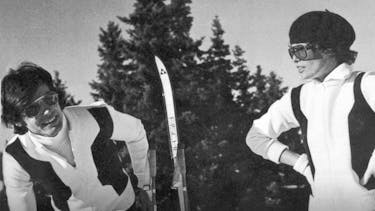Josef Fischer is constantly on the lookout for alternatives to ski equipment, so as to plug the summer gap in ski production. He himself has been a keen tennis player since the early 1970s; and he sees the opportunity to utilise experience with plastic and metal in ski development for tennis. So there are several reasons for Fischer to start developing their own tennis rackets in 1972. But before the first collection, known as "Matchmaker", is presented in 1974 Fischer take over another firm in Ried, the hosiery and knitwear manufacturer Löffler, in July 1973.
Initially people have their doubts about the takeover. The Austrian clothing industry is in deep crisis. However, tennis racket development is already under way, and it might be possible to boost this with a range of tennis apparel from Löffler. In the clothing factory major restructuring takes place. Only Fischer's financial commitment keeps Löffler afloat. New machines are bought. Löffler starts producing socks for tennis and skiing. The first collection for cross-country skiing is presented at the ISPO trade fair in Munich in 1974. One year later Löffler launches the "Matchmaker" line of tennis wear to go with the new racket. The "C4" ski pullover completes the range. Within two years Löffler has made its mark as suppliers of sports clothing.
Löffler tackles the issue of functional sportswear in 1976. Cold feet and damp clothing should be a thing of the past in crosscountry skiing. Löffler experiments with Transtex, a special-purpose polypropylene with which moisture is diffused away from the skin. In conjunction with cotton, which absorbs this moisture, the fabric keeps one's skin dry and warm. In the 1977/78 season Löffler kits the Russian cross-country national team out with special outfits in which the inner layer is knitted from Transtex. At the 1978 Nordic World Championships in Lahti the new material is put to a practical test. At extremely low temperatures the advantages of Transtex come out clearly. This is the breakthough. Subsequently Löffler lands contracts to equip a number of national teams. And to this day Löffler still stands for premium-quality technical sportswear.
In tennis, too, Fischer breaks new ground. In the past tennis rackets were made of wood. Fischer's first racket, the "Matchmaker" (1974), has a composite plastic/aluminium design. And that's not the only surprise Fischer has for the tennis world. Fischer designer Rudolf Ferch presents a black frame, intended to give the new material a distinctive look. The colour black had been virtually taboo in the whitedominated sport of tennis. And Fischer has yet another surprise in store: instead of the oval racket shape customary so far, Fischer presents the "Superform", a kind of smoothed pentagon.
The "Matchmaker" turns into a real commercial success. Within two years the factory in Ried ships 100,000 rackets. Top players in Austria and other countries are signed up. From 1974 on the Austrian champion Hans Kary plays with a Fischer racket. As early as 1977 production capacity in Ried is inadequate to meet the increasing demand. In Ried there is a severe shortage of labour; so Fischer relocates racket production to Hollabrunn, not far from Vienna. Production stays there until 1990, when the increasing pressure to cut costs forces Fischer to move production to the Far East.
Fischer rackets make their first appearance in the lists of Wimbledon winners in 1978, when the legendary South African double Frew McMillan and Bob Hewitt win in this famous tournament. In subsequent years tennis stars such as Stan Smith, Anders Järryd, Horst Skoff and Carl Uwe Steeb put their trust in the racket with the triangle emblem. Michael Stich wins the Wimbledon Men's Singles with the "Vacuum Pro" in 1991. In 1998 Fischer has the no. 1 world ranking player, Yevgeny Kafelnikov, signed up; he takes a gold medal at the 2000 Olympic Games in Sydney, too. The final figurehead players for Fischer include the Cypriot Marcos Baghdatis, who becomes a popular hero in his own country when he reaches the finals of the Australian Open in 2006.

The great days of Fischer's tennis production are the early 1990s, when racket sales reach around 200,000 per year. In 2008 sales are still at 80,000; however, the Tennis Business Unit is no longer profitable at this stage. In July 2009 Fischer sells the moulds and the patents plus all the specialised know-how to the German company Pacific, which has built up a reputation in the field of racket strings.
In the 1970s Fischer breaks new ground with technical apparel from Löffler and a tennis collection of its own. In 1972 the "Europa Sport Aktiengesellschaft" is set up as a holding company (Sport AG) in which, alongside Fischer and Löffler, Kästle and Dynafit are also incorporated.




